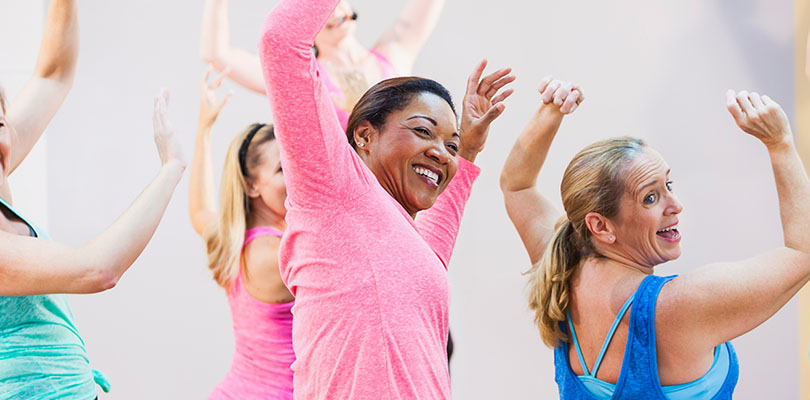Best Exercise to Lose Weight
Losing weight is a balancing act between diet and exercise. You simply can't lose weight long-term without both these tools, according to the American Council on Exercise (ACE).
Too many people opt for dieting alone, which they believe is the easier route. But statistics show that only about 5 percent of dieters are successful at keeping weight off – while the rest get caught in the yo-yo cycle of weight loss and weight gain.
For most people, it's typical to regain about one-third of weight lost within one year. Most will regain nearly all of the lost weight within three to five years, according to ACE. That is why exercise is such an essential part of the weight loss equation.
How To Lose Weight
To lose weight long-term, you need to burn more calories than you consume. You may also need to consume fewer calories. This combination is the best way to lose weight, studies have shown.
The National Weight Control Registry, which since 1994 has tracked more than 10,000 people who shed an average of 66 pounds and kept it off for at least five years. Of this group, 89 percent had success with a combination of diet and exercise, while 10 percent were successful with diet only – and 1 percent used exercise alone.
Also, while diet helps you lose weight, it is exercise that has an important side benefit – as it improves your physical fitness. This helps your body stay healthy and strong as you age.
Exercise becomes even more important as you get older, when natural changes in hormones and muscle mass start to make weight control more difficult.
What's Best Way to Lose Weight: Cardio or Lifting Weights?
Walking is often touted as the easiest way to lose weight. Indeed, the National Weight Control Registry revealed that 90 percent of those who successfully kept weight off were doing this easy cardio every day – simply walking.
However, strength training has gained significant credibility as a way to rev your metabolism and lose weight while you sit (or sleep). A few years ago, Duke University researchers conducted the largest study of its kind to compare the effects of cardio and strength training.
They tracked 199 overweight and previously sedentary volunteers for eight months while each performed aerobic exercise, resistance training, or both forms of exercise. Researchers found that aerobic exercise was most effective in weight loss.
The aerobic exercise group lost about four pounds while the resistance training group gained two – which was attributed to lean muscle. However, that group didn't have any meaningful fat loss.
The aerobics-only group lost more than 3 ½ pounds of fat while the lifters didn't lose a single pound. The lifters even worked out 47 more minutes every week compared to the aerobics group, yet they didn't lose a pound!
Best weight loss results? The aerobics-plus-strength training group, whose members lost the most weight plus the most fat while adding lean mass.
Why Weights First, Then Cardio Second
To get the biggest result, it helps to do the strength training first, followed by aerobics, advises the American Council on Exercise. Their study found that your heart rate is higher – by about 12 beats per minute – during your aerobics workout when you've lifted weights beforehand. This stimulates a bigger calorie burn.
The 9 Best Exercises for Weight Loss
While simply walking can be enough to lose weight, the length of time involved can exceed an hour or two every day. That’s not always practical, so it helps to get strategic.
Women’s Health Magazine has ranked the best exercises for weight loss based on calories burned during your workout. Their estimate is for the number of calories a 125-pound person and a 185-pound person would burn. The more a person weighs, the more calories they tend to burn on any particular task.
This list also offers tips for modifying your workout to fuel a bigger calorie burn after your workout.
Jumping rope
- You’ll burn: 667-990 calories/hour
- For extra burn: Use a weighted jump rope to engage your arms and shoulders even more.
Running
- You’ll burn: 566-839/hour
- For extra burn: Your body will naturally continue burning calories the rest of the day. For even greater burn, alternate with short bursts of sprints or faster running into your jog. Or, if you run for 60 seconds, walk 30 seconds.
Kettlebell Intervals
- You’ll burn: 554-822 calories/hour
- For extra burn: You’ll have a natural afterburn for 36 hours afterward. For best results, switch between upper- and lower-body movements so you can work out longer without getting fatigued.
Kickboxing
- You’ll burn: 582-864 calories/hour
- For extra burn: Keep rest periods between rounds of jabs and kicks at 30 seconds.
Stationary Bike (Vigorous)
- You’ll burn: 498-738 calories/hour
- For extra burn: Start with 10 seconds of intense pedaling and 50 seconds of rest. Then, 15 seconds of sprints and 45 seconds of rest, followed by 20 seconds of sprints, then 40 seconds of rest.
Rowing Machine
- You’ll burn: 481-713 calories/hour
- For extra burn: Row super-fast for one-minute intervals, with 30- to 60-second rest periods. Then switch to pushups, squats, and planks.
Stairs
- You’ll burn: 452-670 calories/hour
- For extra burn: Hold a one- to five-pound dumbbell in each hand to get your upper body fired up, too.
Elliptical trainers (Resistance Level 8)
- You’ll burn: 322-478 calories/hour
- For extra burn: Vary the incline and resistance level during your workout.
Power Yoga
- You’ll burn: 226-335 calories/hour
- For extra burn: A power vinyasa flow class is strength-driven and will give you the best yoga burn.
What causes obesity? There are multiple risk factors of obesity, ranging from age, genetics, lifestyle to certain health conditions and medications.
High-Intensity Workout and Weight Loss
A new type of workout, called high-intensity interval training (HIIT) you can do in less than 10 minutes is gaining attention, and research shows it works. Amazingly, these high-intensity workouts offer the benefits of an hour-long workout in just a few minutes.
Instead of cycling or running for an hour – plus a session of muscle-strengthening activities – a HIIT program compresses it all into a narrow frame of seven to 15 minutes.
During a typical interval-training session, you put your all into a series of short bursts of movement — typically moves like sit-ups, jumping jacks, or planks — and spend 30 to 45 seconds on each one. After each brief interval, you rest to catch your breath and then move on to the next exercise. At the end of the workout, your whole body should feel it.
HIIT Research Results
Several recent studies suggest this regimen confers health benefits that are at least equivalent if not superior to traditional exercise.
The American Council of Exercise conducted a study comparing people who did a HIIT plan for six weeks against folks who did a traditional workout for the same period. The exercise scientists found that the interval-training group saw essentially the same improvements in heart health and muscle tone as the traditional exercisers. However, the benefits took effect in less than half the time.
In their study, researchers randomly assigned a group of 48 men and women aged 21 to 59 to either a HIIT training program or a traditional workout plan. After six weeks, people doing the HIIT regimen saw greater or equal gains in heart health and muscle tone compared to the regular exercisers. The benefits also cropped up three weeks earlier on the HIIT plan.
That's a significant finding since many people give up on a workout plan when they don't see results.
Why HIIT Works for Weight Loss
Researchers find that during high-intensity exercise, glycogen is used at a much higher rate than fat. However, after the exercise is over, the body will continue to use oxygen at a higher rate. This means the body will continue to burn more calories, even while at you are rest.
Also, hormones that are released during a high-intensity workout stay in the blood as much as 48 hours after exercise. These hormones are known to increase metabolism and boost the rate of fat burn.
To sustain exercise intensity to produce this after-burn, researchers advise focusing on intervals of high-intensity movement and rest. You might sprint for 30 seconds, walk for 60 seconds, then repeat 10 to 12 times. You may find this is “too much” on a daily basis, and in fact, it can increase the risk of injury.
Adapting the HIIT concept
You don't have to run, bike or perform any traditional cardio exercise to get high-intensity, fat-burning training. By pairing strength exercises that work opposing muscles, you can build muscle while keeping your heart rate high, maximizing fat loss.
Choose two exercises that use opposite movements or work completely different muscles. Pair a pushing exercise with a pulling exercise or a lower body move with an upper body move.
A few exercise pairs:
- Medicine ball side toss with medicine ball slam
- Kettlebell swing with squat thrust
- Jumping jacks with pushup
- Squat thrust with pushup
Talk to a trainer to make sure you are doing these moves correctly to avoid injury. With these exercise combos, you have to pay attention – and count your reps – which helps you stay engaged in what you’re doing. This helps fuel motivation to finish the workout.
- Set a plan and stick with it. Whatever you decide, the most important thing is committing to doing it regularly. These strategies will help you maximize your weight (and fat) loss forever:
- Schedule your workouts. Keep a calendar that lists specific times for your workouts. Make an appointment with exercise ahead of time, and you won't have the excuse of running out of time.
- Make resistance training a priority. Women have less muscle mass compared to men, which puts them at an evolutionary disadvantage for losing fat. This results in a lower caloric expenditure during rest. Also, women tend to lose lean muscle mass more quickly as they get older.
- Use high-intensity interval training. Moderation is key with HIIT. One to three days weekly of high-intensity interval training, in addition to lower-intensity exercise, provides time for rest and muscle recovery to prolong the fat-burning effect long term.
Research shows that resistance training will increase amounts of lean muscle mass in both men and women. This will increase calorie burn when you’re sitting on your duff (or sleeping), so it should be a priority. Perform exercises that use large muscles for 8 to 12 repetitions – and do it two or more days every week.
Also, women won’t bulk up their muscle mass with this type of exercise, since women don’t have the level of anabolic hormones (testosterone, growth hormone, etc.) necessary to build large amounts of lean muscle mass. This is true even if women do high training intensities.
A Note on Calories and Weight Loss
Don’t focus on severe calorie restriction as the body can slip into “starvation mode” which promotes loss of lean muscle mass. The body is preparing itself for limited calories, so it gets rid of its biggest calorie burner – the muscle.
When the body is in starvation mode, additional calories are stored as fat very quickly. Women seem to be even more sensitive to calorie fluctuations, storing fat quicker after meals. When food was scarce and physical activity was frequent, this storage process kept us alive. In this time of abundance, we have a physiological system designed for scarcity.
The most effective nutritional approach for long-term fat loss is to eat whole, unprocessed food – vegetables, fruits, just a little healthy fat like olive oil. To maintain lean muscle, include lean protein with every meal.







